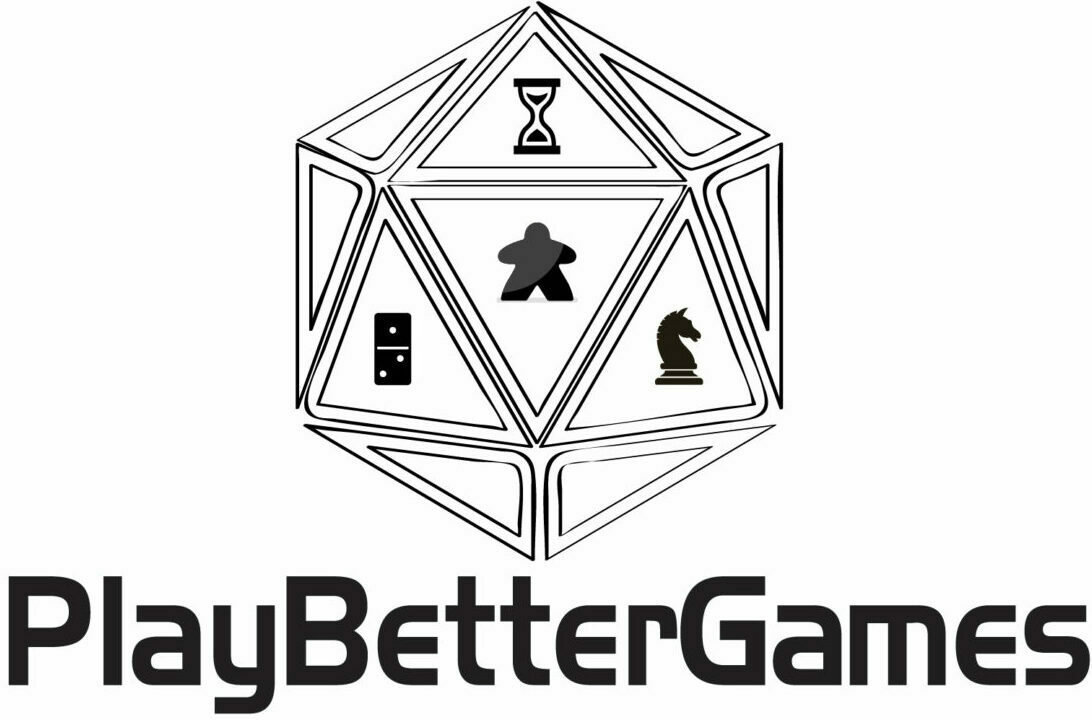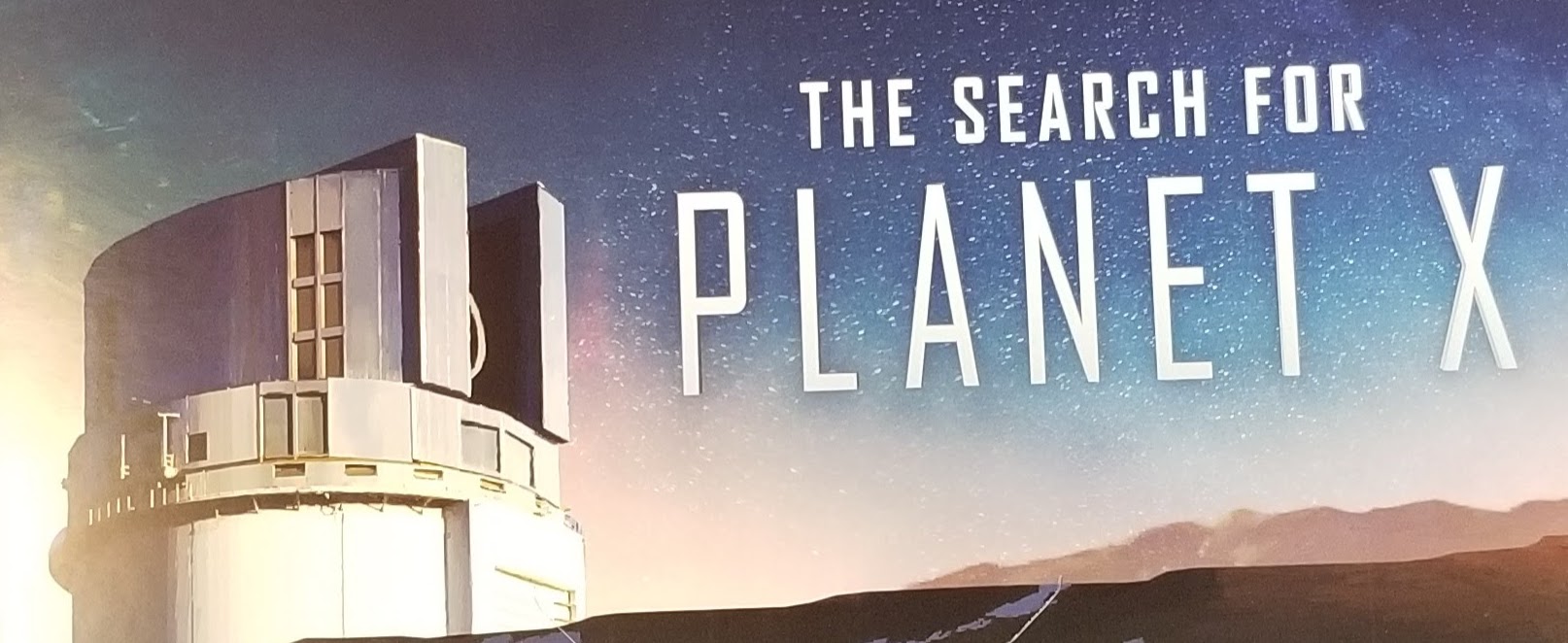Deduction games are incredibly fun. There is something about everyone trying to solve the same logic puzzle that I really enjoy. I’ll admit though, I kind of fell asleep on this genre over the years. We’ve played a lot of social deduction games like One Night Ultimate Werewolf, and Love Letter, because they are good for large groups, but it wasn’t until recently that I started looking at the classic Deduction genre again.
Christin and I were recently introduced to The Search for Planet X by our friends Zac and Maggie and it hits the sweet spot for a fantastic deduction game. The theme works perfectly, it has a companion app that is well designed, and it makes use of a very interesting time-based economy system. We’ll go over all of that in this post so you can decide if this game is right for you.
The Search for Planet X opened my eyes to the evolution of the Deduction genre that I have missed. I’m excited to head down the deduction game rabbit hole and come up with a bunch of games for you that are better than Clue.
- The Search For Planet X Overview
- The Search for Planet X Gameplay
- Winning the Game
- What We Like About The Search For Planet X
- Criticisms of The Search For Planet X
- Is The Search for Planet X Worth the Money?
- Can you Play The Search For Planet X Online?
- Can you Play The Search For Planet X Solo?
- Final Thoughts
The Search For Planet X Overview
The Search for Planet X is a deduction game for 1-4 players. In the game, you play as astronomers working to find the location of a planet. The information you have is limited, and you must continue to research and use logic to determine in which sector of the sky the planet resides. Along the way you’ll also get points for being the first to correctly identify the location of other things like comets, asteroids and dwarf planets.
Most deduction games take the form of a whodunnit, a crime has been committed and you’re trying to solve the case. The Search for Planet X takes a real-world ongoing investigation in the field of astronomy and uses it as the basis of the game instead.
Our friend Zac, a fan of all things meteorological, explained the theme. Astronomers have long theorized that based on the orbits of various moons and celestial bodies there must be a large planet out in the solar system that has yet to be discovered. The gravitational pull of this planet would account for the orbits observed.
The problem is, depending on the size of the planet, there are a lot of places this planet could be. Astronomers are actively looking for this planet today, trying to deduce its location based on other things they observe in space. In this game, that’s what you’ll be doing too.
You’ll all start with a different set of information and a common set of logic rules you can count on to help you deduce the planet’s location. Let’s go over those rules next!
The Logic Rules
In The Search for Planet X, you’ll use things you know about the relationships between different objects in space to help eliminate sectors from your search.
Similar to when you are playing sudoku and you know the following:
- Each Box contains each of the numbers 1-9 exactly once
- Each Row contains each of the numbers 1-9 exactly once
- Each Column contains each of the numbers 1-9 exactly once
Using these rules, and the surrounding numbers you can find the location of other numbers through a process of elimination.
You’ll be doing the same thing here, but the rules will be things like:
- Each sector contains only one thing
- There are exactly two comets
- An Asteroid is never adjacent to a dwarf planet
Some of these rules are the same in every game you play, these are printed on a player aid to help you remember them. Some of the rules change from game to game, and will be found through research you perform in the companion app.
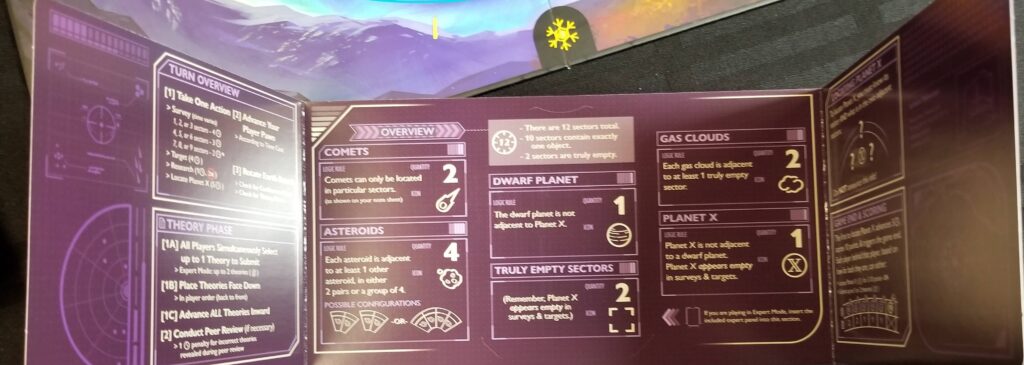
The Visible Sky
As game play progresses there is a piece in the center of the board that you will rotate. This simulates the Earths orbit around the sun, on each side of the board there is an icon to represent the season. Depending on which season it is certain portions of the sky will be visible.
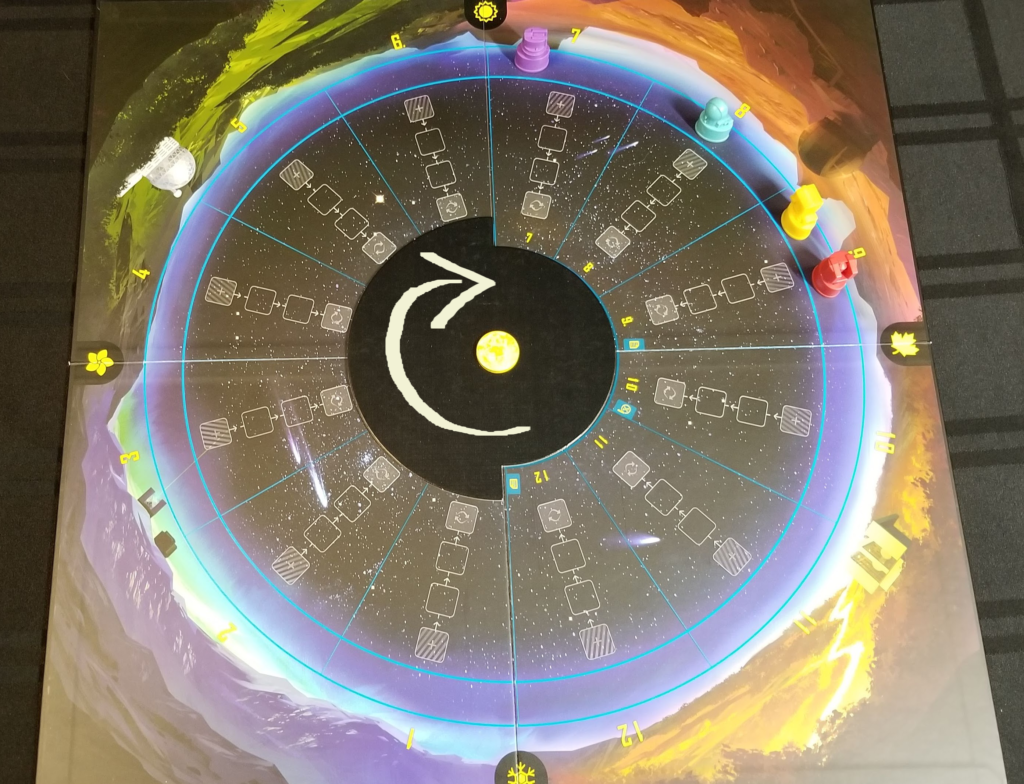
The area of the board not covered by the largest part of the rotating disc is the visible sky. To make demonstrate this, I have highlighted the visible sky in green in the next image.
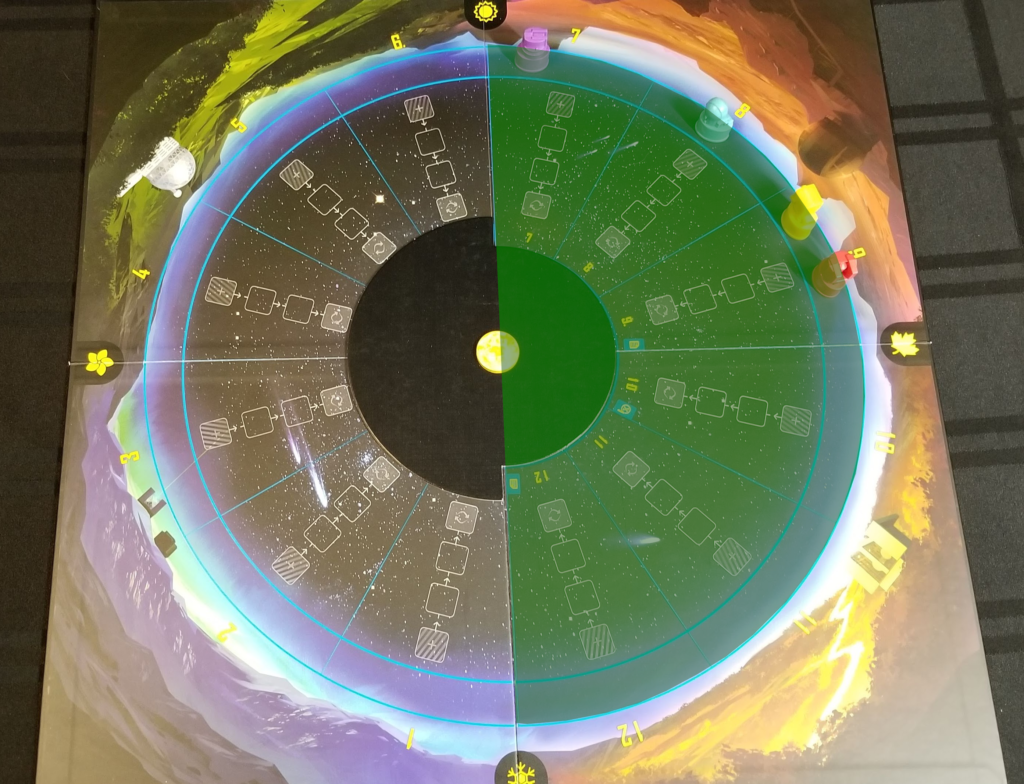
Throughout the game the players will. be moving their token around the outer ring of the board (the time track), and at the end of each turn you will move the inner disc so it lines up with the player furtherest back on the time track.
The Search for Planet X Gameplay
The game relies heavily on a companion app, in fact without the app you can not play the game. You only need the app on one device that you can pass around the table, but it’s best if everyone has their own. The app is free to download, so players can easily put it on their phone.
Starting Information
Depending on the side of the board you’re sitting on (designated by the season Icon) you’ll get a tracking sheet. The sheet will show the sectors of the sky in the same orientation that you see the board from your seat. Each player will start with different information which will be provided by the app.
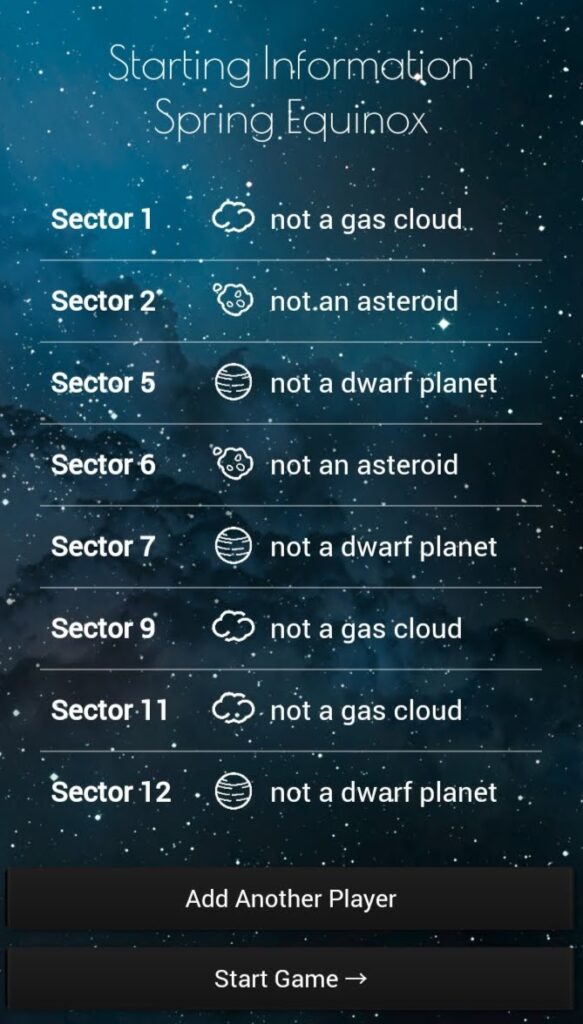
This is information you can rely upon, like the starting numbers in a Sudoko puzzle.
Conduct Research
Throughout the game you’ll be able to conduct various actions that all take different amounts of time to complete. If you survey the sky you specify a range of the visible sky (ie sectors 7-10) and choose a celestial object (ie comet), the app will tell you how many of those objects appear in that range, but not where they are. When you target a sector the app will tell you exactly what’s there (you can only do this twice per game). Conducting research takes the least amount of time, and will provide you with an additional logic rule that applies to this instance of the game.
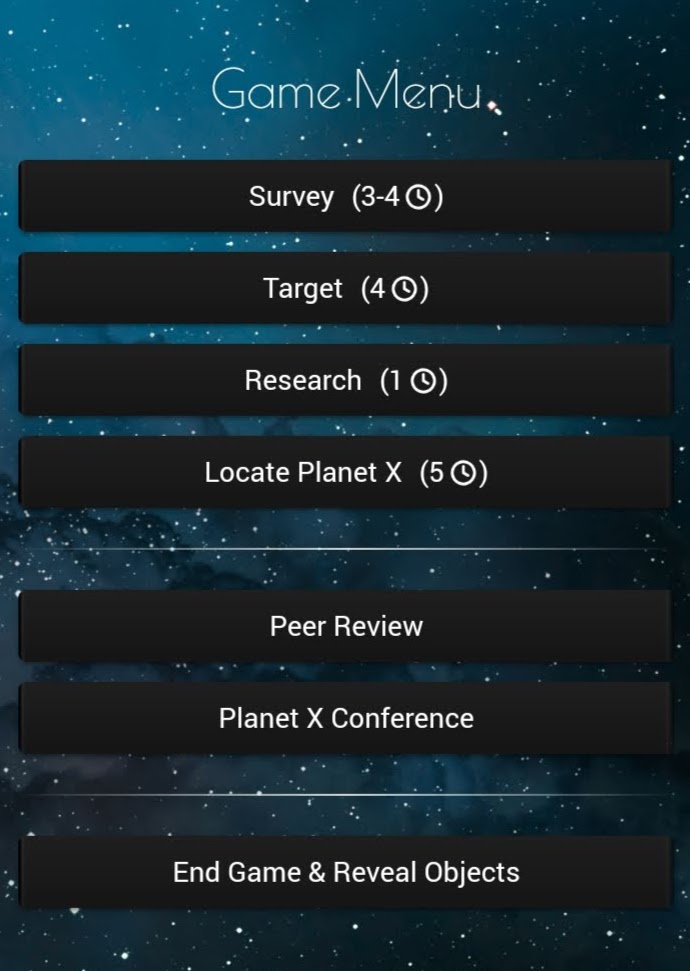
After you’ve completed your action you move your player token (represented by colored observatories) around the outside of the board, one sector per unit of time spent. I’ve highlighted the time track in green to make it easy to see.
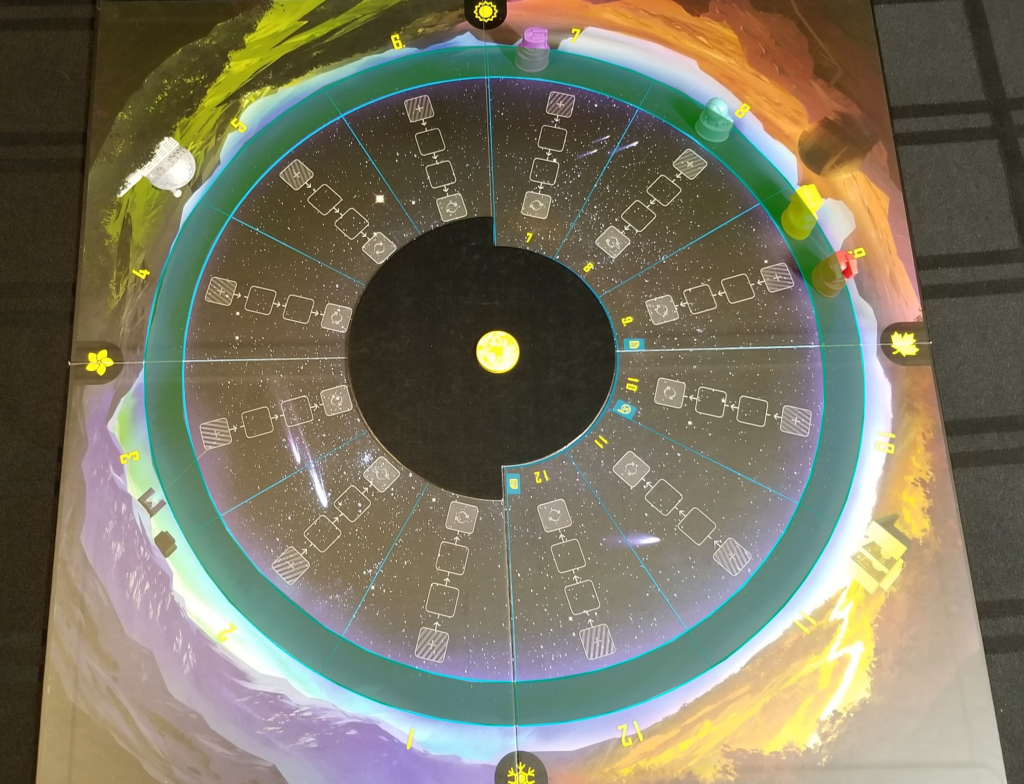
After each turn rotate the center disk so the longer section lines up with the start of the sector where the observatory that is furtherest back resides, that player then takes their turn. It is possible if you take an action that is fast to take multiple turns in a row.
Publish Papers
At various points in the game you can publish up to two papers. When you do this you place a marker of your color in a sector that signifies what you think is located there. Each time papers are submitted, existing papers move toward the center of the board. When they reach the center of the board they are turned over for all to see and you perform Peer Review in the app to see if the players were correct. You get points correct identification, and more points for being the first player to correctly guess what is in a sector.
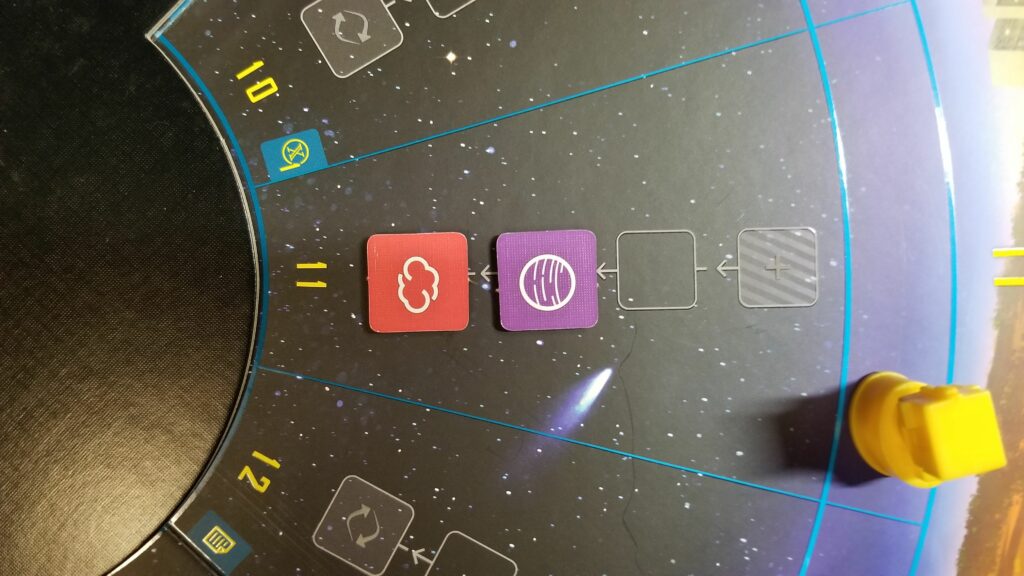
There is an interesting push and pull here. You want to be the first player to correctly guess what’s in a sector, but by doing so you are revealing to other players what you know. So you’ll want to hold off as long as possible before submitting your theories!
Empty Sectors
There are two sectors that are empty, and the sector containing Planet X will appear empty as well. Even if you’re targeting a sector to find out what’s there, the app won’t tell you “Planet X is here”, but you’ll be able to find the three empty sectors and use the logic rules to determine which one is not actually empty.
Winning the Game
The game ends when someone finds Planet X, but the researcher who finds Planet X may not be the winner. Scoring is determined by not only finding Planet X but also the correct theories you submitted along the way!
What We Like About The Search For Planet X
The Companion App
The App is really well done, it is required to play and feels pivotal to the experience. It does not ever feel clunky or like it’s in the way it is really well designed and does exactly what it needs to do. No more, no less.
The Time-Based Economy
Something this game does really well is implement a simple time-based economy. We’ve seen this before in games like Patchwork, and it works just as well with this theme. Just like in real life, some types of research take longer to perform than others. Players who take more time-intensive actions may get more information, but players who take shorter actions take more turns. There is strategy in managing your time efficiently.
Varying levels of Difficulty
There are two sides to the board, one that divides the sky into 12 sectors and one with 18. As players get better at the game they can use the other side of the board for a more challenging experience. You can also set the difficulty level in the app which will control how much information the game gives you to start. This difficulty can actually be set per player so if you’re playing with more experienced puzzlers, or have a mix of adults and children you can adjust the difficulties as you see fit.
Seasonal Tracking Sheets
This is a small thing but it makes a big difference. Being able to give players a tracking sheet that orients the sectors to match the view of the board from the side they are playing on is a really nice touch!
Criticisms of The Search For Planet X
The only gripe I have with this game is I wish it could play up to six players. We have a lot of friends who enjoy this type of game and frequently have more than four people at game night. Only allowing for four players limits the number of times we can get this one to the table.
Is The Search for Planet X Worth the Money?
The Search for Planet X is definitely worth the money! It is incredibly well done and it’s nice to have a deduction game with a theme that is not a murder mystery. It’s also a game with perfect information, so for you logic purists out there this is a fantastic game for you. It’s a race to solve the puzzle, but you can also try to glean information from what your fellow players do.
If you’d rather play a deduction game of the who-dunnit variety that doesn’t rely on perfect information please checkout our review of Awkward Guests, which is the best murder mystery deduction game we’ve ever played.
Can you Play The Search For Planet X Online?
As of the time of this writing I am not aware of an online version of this game. You will need a physical copy and Internet access for the companion app.
Can you Play The Search For Planet X Solo?
The Search for Planet X does have a solo mode that you can play with just one player and the app. It also accommodates up to four players.
Final Thoughts
This is a great game! The theme is perfect for a deduction game and is a nice departure from a “who-dunnit”. The components are well made, the app works exactly how you’d want it to, and the game doesn’t overstay it’s welcome (Plays in about an hour). If you are a fan of logic puzzles you really should check this one out!
